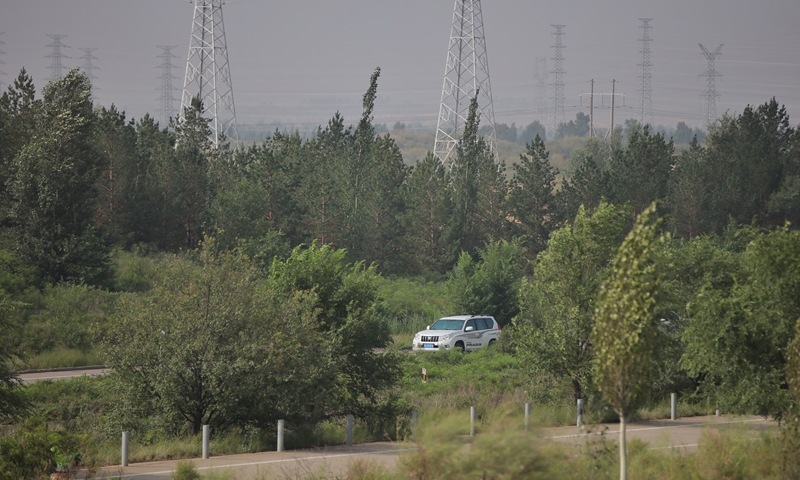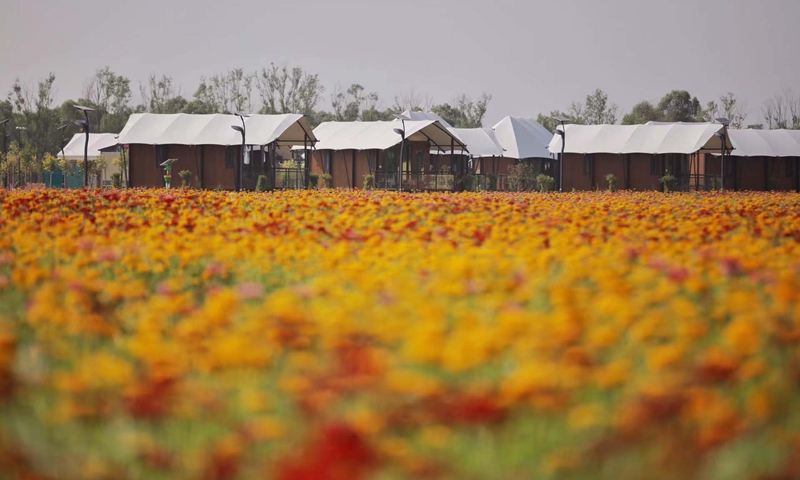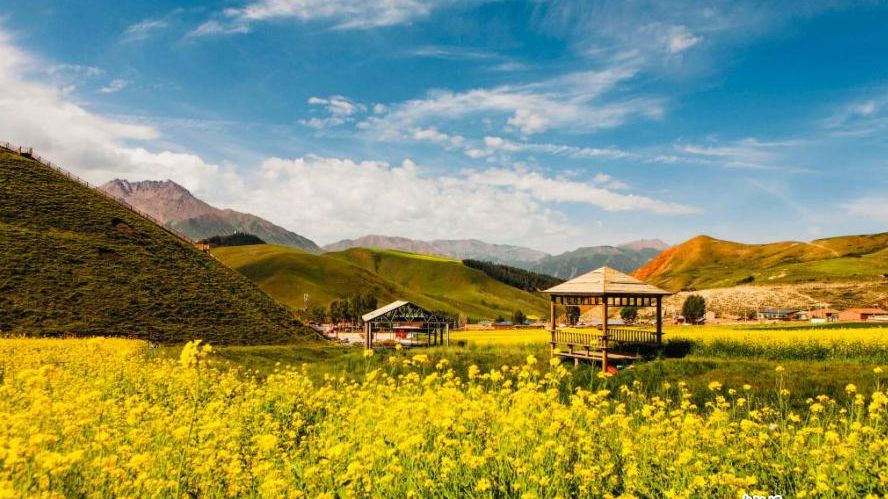From desert highway to green corridor: a glimpse into Yulin, NW China

Grass grids built in 2000. File photo: courtesy of Yujing branch of Shaanxi Transportation Holding

Photo: Xiao Yi/ China Economic Weekly
"The toll station was never cleaned up, always covered by sand and dust," Wang Chan, a resident in Yulin of Northwest China's Shaanxi Province, recalled her experience in 2010 when she started to work at the Yulin-Jingbian section of a local highway, the first built in a desert in China.
But in 2022, "we clean the booth once a day and no longer feel the sand 'cutting into our face'" Wang told the Global Times on Tuesday. Thanks to locals' unswerving efforts to restore plants and improve ecology, the highway has become a green corridor and an epitome of local development's governance - protecting environment first and exploring opportunity based on that.
More than 160 of the 204-kilometer Yulin-Jingbian highway section was in Maowusu desert when the project was planned in 2000, but the Global Times reporter barely see any uncovered desert when standing at a highland close to the highway, only light green bushes and dark green pine trees.
The greenness was achieved through scientific design at the beginning and dedicated care-taking in the past two decades.
Highway builders used a special machine to consolidate the soft sand and make it possible to be road base, but this process come with the big problem of how to prevent damages to the road base caused by the drastic temperature differences from day to night and gradual wind erosion, the Global Times learned from the highway management team.
Builders first set straw checkerboard, also called grass grids, along both sides of the highway, which can keep some moisture for grasses and bushes to grow. Once these bushes "grasp" sand and trap more moisture, larger bushes and trees like pine and cypress can grow, according to the team.

Photo: Xiao Yi/ China Economic Weekly
Now, a comprehensive plantation structure was established - a belt of trees to divide ways on opposite directions, a 20-meter-wide plain ground where high trees are planted, a zone 100 to 500 meters wide where bushes grow to keep sands away, and 500 meters of protected zone where grazing is strictly banned to protect the natural plantation.
"With such a structure, more than 70,000 mu (4,600 hectares) of deserted lands were turned green, and plantation coverage along the highway exceeded 90 percent," Li Chuangjun, chief of the Yujing branch of Shaanxi Transportation Holdings, told the Global Times.
The green corridor has become a key route for highway transportation linking Xi'an, an important city for the China-proposed Belt and Road Initiative and North China's Inner Mongolia Autonomous Region, which further extend to land ports toward Central Asia.
Li said proudly that the highway has become a name card for Yulin's sand control, yet it is only one episode of generations of Yulin people's efforts and achievements in desertification control, which brought local forest and grass coverage rate from 1.8 percent in 1949 to 45.8 percent today.
Another episode of the eulogy to local sand control should be dedicated to a team of female militias.
In 1974, 54 female militias, averaged 18 years old, came to Bulanghe township in Yulin to battle the growing desert, forming the Great Wall women's militia sand control battalion, the predecessor of Bulanghe women's militia battalion.
The women built shelters from Salix Mongolica (a bush plant adaptable to salinized land) and dirt, overcame extreme heat in summer and coldness in winter, they carried saplings and water from several kilometers away and planted the first greenness.
He Shalian, one of the first 54 young women, recalled the 10 years she spent at Bulanghe. "There was no road, so we built the road. There was no water, so we dug wells for water."
He Shalian and her fellows planted 170,000 trees in a decade, and more importantly, she was the teacher for illiterate women. They worked in the day and studied at night, dedicating their youth and passion to the great cause of desertification control.
Since 1974, 380 women had joined the militia, and they jointly left a precious treasure - 33 tree belts, 35 kilometers of irrigation channels, 36 wells. Meanwhile, 800 sand dunes were erased and 14,000 mu of desert were tackled and converted into greenness, the border of desert and greenness was pushed northward 400 kilometers.
In recent years, more and more social capital was introduced and Bulanghe township also developed carbon sink forests, commemoration forests and many other innovative ways to engage more people to participate in afforestation.
Standing at a watchtower built to monitor bush fires, the Global Times reporter saw no trace of desert but only tall and low trees in all directions.
The forests have also changed local micro-climate and gave an opportunity for more different types of plants to prosper. At the proximity of the women's militia company's station were fields of cosmos and verbena. The past desert has become a grand garden, attracting hundreds of thousands of tourists each year, the Global Times learned.
Another name known to all Yulin people is Shi Guangyin, a Yulin native and renowned sand fighter who received the July 1 medal in 2021.
Shi luckily survived a sandstorm after being blown away kilometers away in his childhood but lost his friend in the incident. He then dedicated his lifetime to one only thing - sand control.
Shi became a long-term lease contractor in 1980s to plant trees on government-allocated wasteland including barren hills, sandy beaches, slopes and ditches and encouraged more than 300 fellow villagers to march into Maowusu for a greener future.
Decades later, Shi still has not taken a break but is leading his fellow fighters to explore how to plant economically viable crops and allow the planters and farmers to benefit more from the greener landscape.
Zhaojiamao, a small village 40 kilometers southeast of Yulin city center, is doing similar things. Upholding the belief that lucid waters and lush mountains are invaluable assets, the small village restored local ecology by "returning farmland to forests," and planting bushes and trees.
A better environment not only improved locals' living standards but also opened a chance for developing rural tourism by combining rural scenery, activities such as fruit picking and outdoor barbecue as well as some river-based activities.
With these measures, as well as shareholding mechanism to operate village's collective properties, Zhaojiamao ripped off its label as a poverty-stricken village and become a pioneer for rural revitalization. In 2021, disposable income per capita reached 23,000 yuan ($3,406), far exceeding the province's average of 14,700 yuan.
Yulin has also become a window for international exchanges on afforestation. In 2018, a delegation from Pakistan visited Bulanghe to learn from local anti-desertification experience. In 2020, media representatives from countries Georgia, Kazakhstan, Tajikistan, Nepal and Yemen held a virtual meeting with Yulin locals to exchange their experience on sand control and poverty reduction.
Yulin people's great achievement of choking off the Maowusu desert has impressed the world.
More than 2,000 years ago, the area of today's Yulin city was an oasis with a warm and humid climate. But it had been frequently infested by wars and marred by expanding desertification of the nearby Maowusu, with the increasingly dry climate making it worse. The place became nearly inhabitable around the period of Ming Dynasty (1368-1644).
But today, Yulin has been converted from a battlefield between desert and human beings back into an oasis. The local people shared the same vision that they are going to continue on this great cause and seek a happy life through a harmony with nature.
Photos
Related Stories
Copyright © 2022 People's Daily Online. All Rights Reserved.









